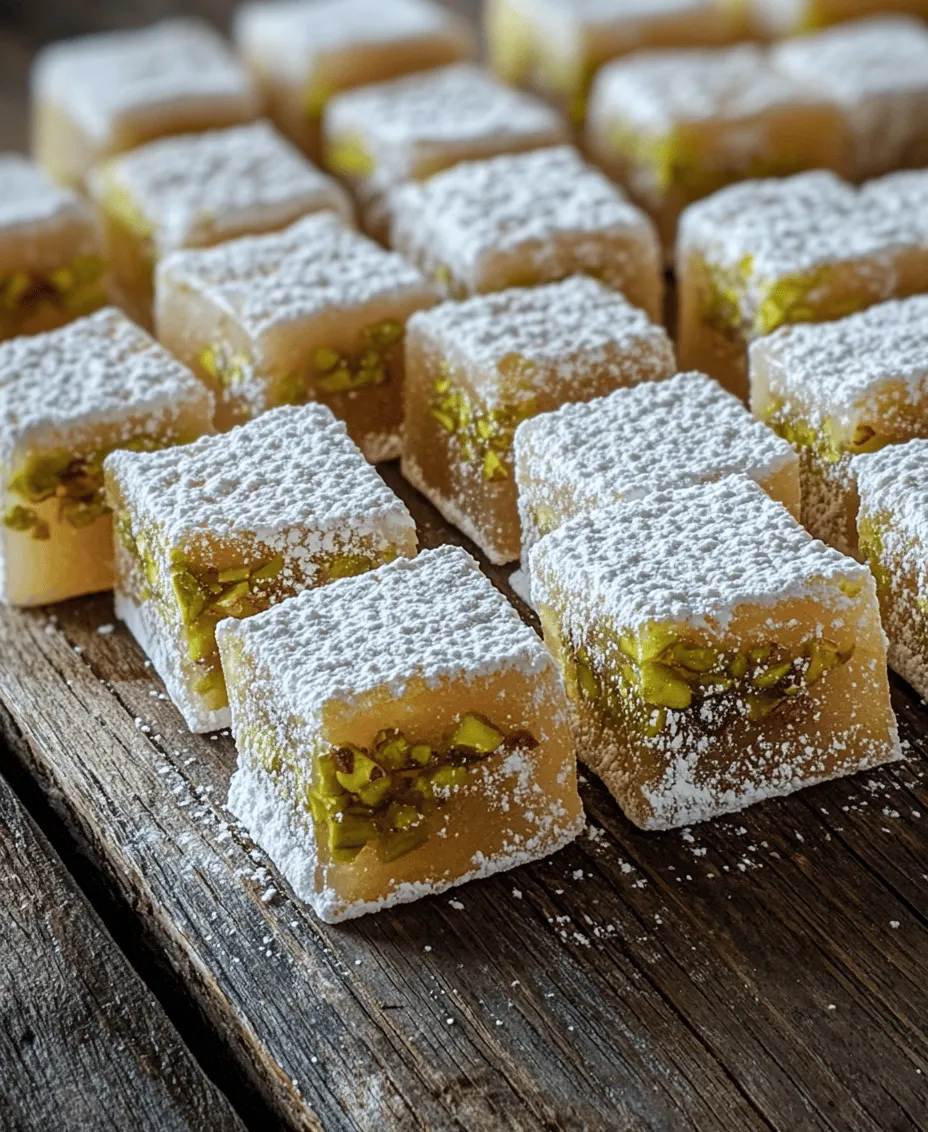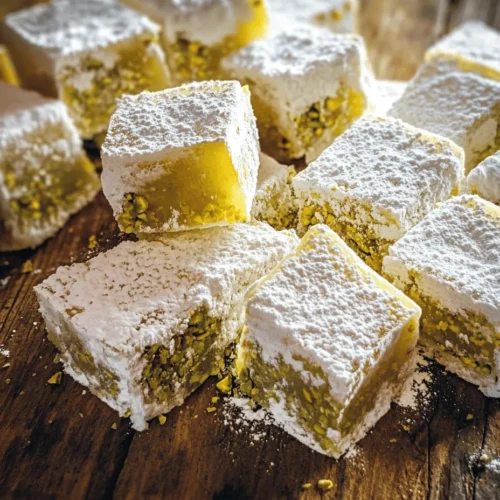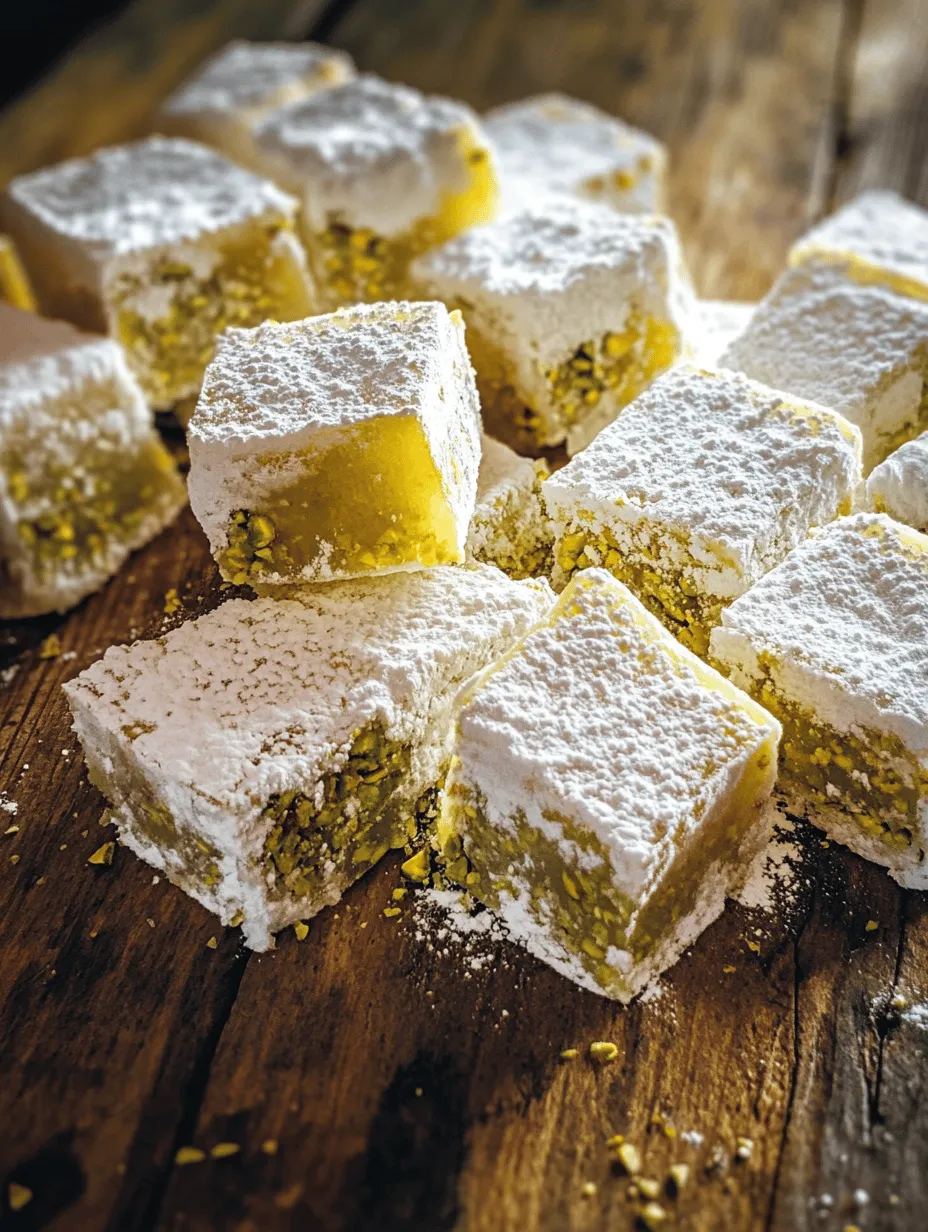Introduction
Turkish delight, or Lokum, is a confection that has enchanted taste buds and hearts for centuries. This delicately flavored, chewy candy holds a special place not only in the culinary world but also in the cultural tapestry of Turkey and the broader Middle Eastern region. For many, the experience of making and enjoying Turkish delight conjures feelings of nostalgia, evoking memories of family gatherings, festive celebrations, and the sweet aroma wafting through the kitchen.
In this article, we aim to provide you with a comprehensive, step-by-step guide on how to create this delightful treat in the comfort of your own home. Whether you’re a seasoned cook or a curious beginner, preparing Turkish delight is a rewarding process that allows you to connect with a tradition that spans generations.
Understanding Turkish Delight
Historical Background of Lokum
The origins of Turkish delight can be traced back to the Ottoman Empire, with its first documented appearance in the late 15th century. The confection was initially created by a confectioner named Bekir Effendi, who opened a shop in Istanbul. He crafted Lokum as a way to satisfy the sweet cravings of the sultans and their court, and it quickly became a popular delicacy among the general populace as well.
As the Ottoman Empire expanded, so did the popularity of Lokum. It evolved from a simple sweet into a symbol of hospitality and tradition, often served to guests as a gesture of goodwill. The name “Lokum” itself is derived from the Arabic word “lokma,” which means “a morsel” or “a bite,” perfectly encapsulating the treat’s nature.
Over the centuries, Turkish delight has adapted and transformed, with various regions adding their unique flair. While it is primarily associated with Turkey, variations of Lokum can be found throughout the Middle East and Mediterranean countries, each with distinctive flavors and textures.
The Role of Lokum in Middle Eastern and Mediterranean Cultures
In many Middle Eastern and Mediterranean cultures, Turkish delight is more than just a sweet treat; it is deeply ingrained in social customs and traditions. It is often served during special occasions such as weddings, religious holidays, and family gatherings. Offering Lokum to guests is viewed as a sign of respect and hospitality, symbolizing the sweetness of the bond shared with them.
Moreover, Turkish delight has become a cherished gift, beautifully presented in decorative boxes, making it a popular choice for special occasions and celebrations. Its presence in cultural rituals further cements its significance as a beloved confection that transcends generations.
Common Variations and Flavors of Turkish Delight
Turkish delight comes in a multitude of flavors and textures, catering to a wide array of palates. The classic varieties often include rosewater, lemon, and orange blossom, each providing a distinct aroma that transports the senses. However, modern interpretations have expanded the flavor profile to include everything from mint and pomegranate to chocolate and pistachio.
In addition to the range of flavors, Turkish delight can also feature various ingredients. Some versions incorporate nuts, such as walnuts, hazelnuts, or pistachios, adding a delightful crunch to the chewy base. Others may be dusted with powdered sugar or desiccated coconut to enhance both flavor and aesthetics.
As you embark on this culinary journey to create your own Turkish delight, you’ll have the opportunity to experiment with different flavors and ingredients, personalizing the recipe to suit your taste.
Essential Ingredients for Turkish Delight
Creating authentic Turkish delight requires a handful of essential ingredients, each playing a vital role in achieving the perfect texture and flavor. Here’s a closer look at what you’ll need:
Granulated Sugar
At the heart of Turkish delight is granulated sugar, which not only provides sweetness but also contributes to the chewy texture of the candy. The sugar is dissolved in water to create a syrup, which is then cooked to the right temperature to achieve that signature consistency. It’s essential to use granulated sugar for the best results, as alternatives may not yield the same chewy texture.
Water
Water is a crucial component in the syrup-making process. It helps dissolve the sugar and is essential for the cooking stage, where it combines with cornstarch to create the base of the Lokum. The amount of water used can affect the final texture, so it’s important to measure carefully.
Cornstarch
Cornstarch is a key ingredient that gives Turkish delight its distinctive chewy texture. It acts as a thickening agent, forming a gel-like consistency when combined with the sugar syrup and water. The correct ratio of cornstarch to liquid is vital; too little may lead to a crumbly texture, while too much can result in a gummy finish.
Lemon Juice
Lemon juice serves multiple purposes in the Turkish delight recipe. Firstly, it acts as an acid, balancing the sweetness of the sugar. Secondly, it helps to stabilize the mixture and prevent crystallization, ensuring a smooth and glossy finish. The zesty flavor also adds a refreshing element to the overall taste profile.
Cream of Tartar
Cream of tartar is another stabilizing agent that plays a role in the cooking process. It helps maintain the integrity of the sugar syrup, preventing it from becoming too dense or crystallized. Adding cream of tartar ensures a consistent texture and flavor throughout the batch of Lokum.
Rosewater and Orange Blossom Water
Traditional flavoring agents like rosewater and orange blossom water are what truly set Turkish delight apart. These aromatic essences infuse the candy with floral notes that are both fragrant and delightful. While rosewater is the most commonly used flavoring, orange blossom water offers a unique alternative that brightens the overall profile. Depending on your preference, you can choose to use one or both in your recipe.
Nuts
Incorporating nuts into your Turkish delight adds a delightful crunch and enhances the flavor. Common choices include pistachios, walnuts, and hazelnuts. These nuts not only provide contrast in texture but also complement the sweetness of the Lokum beautifully. You can choose to add them to the mixture or use them as a garnish when serving.
With a solid understanding of the historical significance and essential ingredients of Turkish delight, we are now ready to delve into the step-by-step process of creating this beloved confection. In the following sections, we will guide you through each stage, ensuring you can recreate this timeless treat and share it with friends and family for generations to come.

Powdered Sugar and Cornstarch Mixture: Importance for Dusting and Preventing Stickiness
When making Turkish Delight, one of the essential elements to consider is the combination of powdered sugar and cornstarch. This mixture serves a dual purpose: it prevents the sticky confection from clinging to surfaces and each other while also enhancing the overall texture. By dusting the Turkish Delight with this blend, you not only ensure easy handling but also create a beautiful outer finish that enhances its appeal. The ideal ratio is typically three parts powdered sugar to one part cornstarch, which provides both sweetness and a smooth, non-sticky surface.
Step-by-Step Instructions for Making Turkish Delight
Preparing the Baking Dish
Before diving into the cooking process, it is crucial to prepare your baking dish properly. Start by greasing an 8-inch square baking dish with a light coating of oil or butter. This step ensures that the Turkish Delight can be easily removed once it has set. Following this, line the dish with parchment paper, allowing some overhang on the sides. This will make it even easier to lift the set candy out of the dish. Greasing the parchment paper lightly will also help prevent any sticking.
Making the Sugar Syrup
The sugar syrup is the heart of Turkish Delight, and achieving the right consistency is vital. In a medium saucepan, combine 2 cups of granulated sugar with 1 cup of water. Over medium heat, stir the mixture until the sugar dissolves completely. Once the sugar is dissolved, increase the heat and bring the mixture to a boil. The key is to monitor the temperature closely; you are aiming for the soft ball stage, which occurs at 240°F (115°C). To check, you can drop a small amount of the syrup into a glass of cold water. If it forms a soft, pliable ball, you’ve reached the desired stage. Remove the saucepan from heat and set aside.
Combining Cornstarch and Water
While the sugar syrup is cooling, prepare the cornstarch mixture. In a separate bowl, combine 1 cup of cornstarch with 1 ½ cups of cold water. Whisk this mixture until it’s smooth and free of lumps. This mixture will help to thicken the Turkish Delight and give it its signature chewy texture. After whisking, set it aside while you continue with the next steps.
Thickening the Mixture
Now it’s time to bring everything together. In a large saucepan, combine the sugar syrup with the cornstarch mixture over medium heat. Stir continuously using a wooden spoon or spatula to prevent any lumps from forming. The mixture will start to thicken after about 10-15 minutes of cooking. Continue stirring for approximately 30-45 minutes, or until the mixture becomes thick and pulls away from the sides of the pan. You’ll know it’s ready when it resembles a thick paste, similar to the consistency of a very thick pudding.
Adding Flavorings and Nuts
Once the mixture has thickened to the desired consistency, it’s time to add flavorings and any optional ingredients. Traditional Turkish Delight often features rosewater or orange blossom water, which can be added at this stage to infuse the sweet with floral notes. Start with 1-2 teaspoons and adjust to your taste preference. Additionally, you can fold in chopped nuts such as pistachios, walnuts, or almonds for added texture and flavor. Make sure to mix thoroughly so that the flavorings and nuts are evenly distributed.
Pouring and Setting
With the mixture ready, pour it into your prepared baking dish. Use a spatula to spread it evenly and smooth out the surface. To ensure that the top is as smooth as possible, you can lightly wet the spatula or use a piece of parchment paper to press down gently. Once poured, allow the Turkish Delight to set at room temperature for at least 4-6 hours or overnight, which will help it achieve the perfect chewy texture. Avoid refrigerating, as this can alter the texture and make it too firm.
Cutting and Dusting
After the Turkish Delight has set, it’s time to cut it into pieces. Use a sharp knife or a pizza cutter to slice the candy into squares or rectangles. For the best results, dust your cutting tool with the powdered sugar and cornstarch mixture to prevent sticking. Once cut, generously dust the pieces with the sugar and cornstarch mixture, ensuring that each piece is coated on all sides. This not only prevents them from sticking together but also adds an appealing finish.
Storing Turkish Delight
To store your homemade Turkish Delight, place the pieces in an airtight container, separating layers with parchment paper to prevent sticking. Ideally, keep the container in a cool, dry place away from direct sunlight. Properly stored, your Turkish Delight can remain fresh for up to two weeks. If you plan to keep it longer, refrigeration can extend its shelf life, but be cautious of the texture change.
The Experience of Making Turkish Delight
Making Turkish Delight is not just about following a recipe; it’s an immersive experience that engages all your senses. The sweet aroma of simmering sugar and floral notes from the flavorings fill your kitchen, evoking memories of family gatherings and cultural celebrations. The transformation of simple ingredients into a beloved confection is truly magical, allowing you to appreciate the artistry involved in traditional candy-making.
As the mixture thickens and your kitchen fills with enticing scents, you may find joy in the memories associated with this treat. Turkish Delight plays a significant role in many cultural celebrations and gatherings, symbolizing hospitality and sweet moments shared with loved ones. Whether it’s during festive occasions or a casual get-together, offering homemade Turkish Delight invites smiles and warmth, making it a cherished addition to any gathering.
Conclusion
Making Turkish Delight at home is a rewarding endeavor that connects you with a rich culinary heritage. The process allows you to appreciate the craftsmanship behind this beloved treat while creating sweet memories in your kitchen. With each step, from preparing the baking dish to savoring the final product, you engage not only with the ingredients but also with the traditions that have been passed down through generations.
I encourage you to take the time to try this recipe and experience the sweet nostalgia of Turkish Delight. There’s a unique joy in sharing your homemade creations with friends and family, allowing them to taste the love and effort you’ve put into crafting each piece. Embrace the opportunity to create something special that reflects your connection to culture and tradition. The simple act of making traditional confections like Turkish Delight not only brings delight to your taste buds but also serves as a beautiful reminder of the moments that connect us all.



